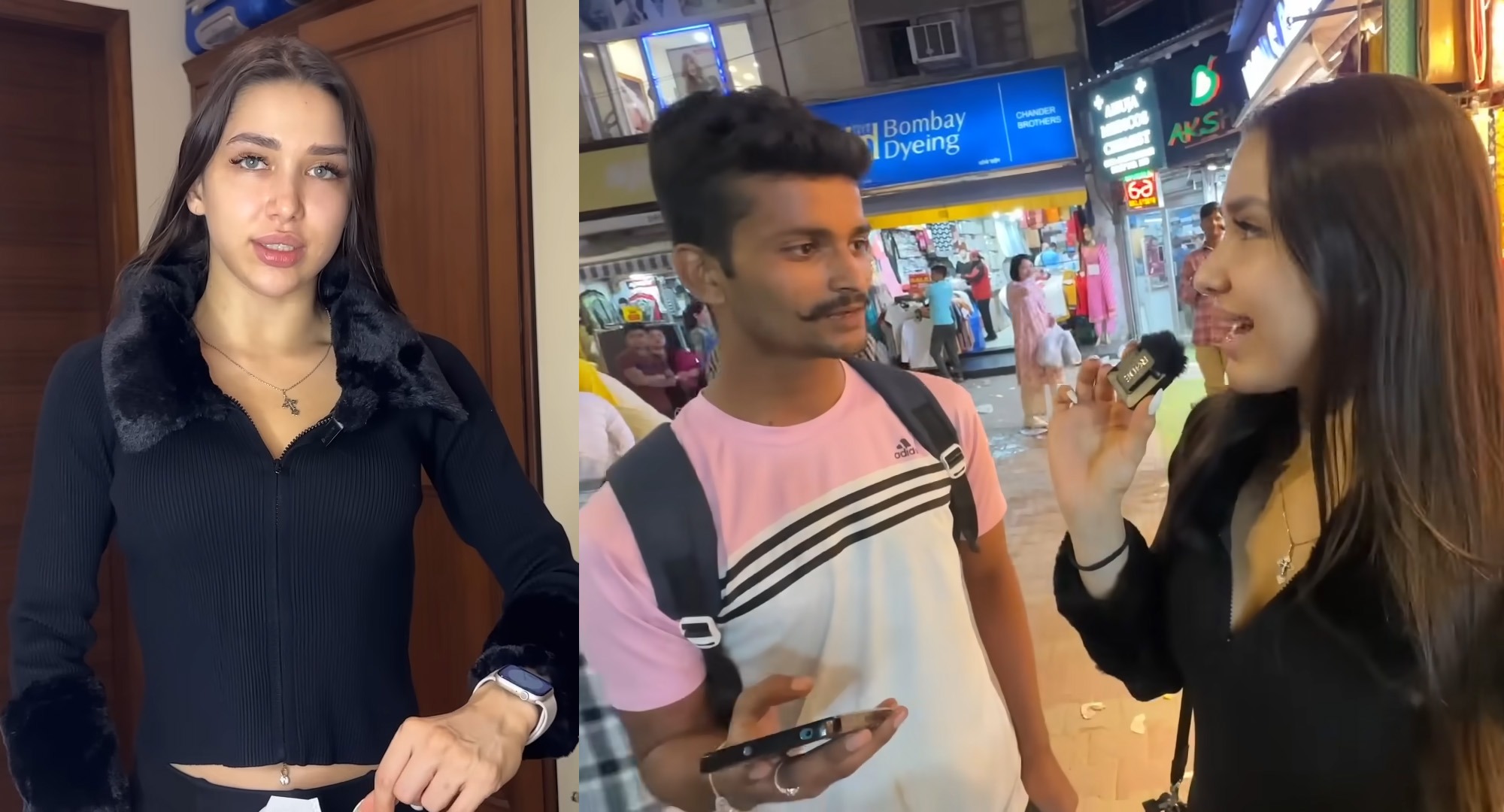Kristina Koko In India Viral Video Explained The Truth Behind the Sensation
The phenomenon of viral videos is not new, but every so often a particular clip seizes the attention of millions across the globe. One such instance is the case of the Kristina Koko video that took India by storm. This incident—marked by its rapid spread, polarized reactions, and cultural implications—offers a fascinating glimpse into the modern dynamics of social media, celebrity culture, and the intricacies of digital fame. In this article, we explore the incident in detail, discussing who Kristina Koko is, what transpired in the viral video, and why it has sparked widespread discussion in India. We will analyze the narrative behind the video, its reception among various communities, and the broader implications for public discourse and media literacy in a rapidly evolving digital landscape. Drawing on insights from the original explanation by Socially Keeda , this article presents a comprehensive look at the context and controversies surrounding the video, while also considering its role as a case study in global digital culture.
With the ever-increasing pace at which information is shared online, the Kristina Koko video has become more than just a clip—it has morphed into a conversation starter about authenticity, representation, and the responsibilities of both content creators and audiences. In the sections that follow, we will break down the incident into its key elements: the background of the star, the specifics of the viral moment, the ensuing public reaction, and an analysis of its broader cultural impact. By dissecting the layers of this phenomenon, we aim to provide clarity and context to what might initially seem like just another piece of online content, yet is emblematic of larger trends in global media.
Background of Kristina Koko
Understanding the viral video requires delving into the background of its central figure, Kristina Koko. While relatively unknown to many before the incident, her sudden thrust into the limelight has sparked curiosity about her origins, her digital presence, and the factors that led to her becoming a subject of intense public scrutiny. Kristina Koko is not a household name by traditional standards; rather, her rise is intertwined with the dynamics of modern social media, where even minor public appearances can be amplified into international phenomena.
Born and raised in a modest setting, Kristina’s journey into the world of digital fame began when she started sharing snippets of her life on various platforms. Her content, which initially focused on everyday moments and personal style, gradually evolved into a broader narrative that resonated with a diverse audience. Many viewers found her candid and relatable, which contributed to the rapid spread of her content online. However, it was a particular video—soon dubbed as “the viral moment”—that catapulted her from obscurity to prominence. The video, which has been dissected and debated across multiple platforms, features elements that are both intriguing and controversial, making it a perfect storm for virality in a country as digitally connected as India.
The background of Kristina Koko also highlights the role of social media algorithms in amplifying content. Platforms designed to prioritize engaging material helped accelerate the spread of her video. This phenomenon raises important questions about how digital fame is constructed and the responsibilities of both creators and the platforms that host them. Her story, as discussed in detail on Socially Keeda , serves as a microcosm of the current state of online celebrity culture—a landscape where talent, chance, and the workings of digital networks intersect in unpredictable ways. Moreover, her experience underscores the complexities of navigating a public persona in an age when every moment can be shared and scrutinized on a global scale.
Beyond the immediate context of the video, Kristina’s narrative touches upon broader themes such as authenticity, media representation, and the transient nature of internet fame. While her sudden burst of popularity may seem serendipitous, it is also a reflection of a digital ecosystem that values rapid engagement over long-term credibility. As we continue to explore the details of the viral incident, it becomes clear that Kristina Koko’s background is not just a personal story—it is emblematic of the evolving relationship between individuals and mass media in the 21st century.
The Viral Video Incident
At the heart of this phenomenon is the video itself—a brief yet compelling clip that quickly became a subject of national debate in India. The video, which appears to capture an unscripted moment, drew immediate attention due to its unusual content and the way it seemed to challenge conventional expectations of public behavior. The scene depicted in the video, set against a backdrop that resonated with local audiences, became a flashpoint for discussions on authenticity and performance in the digital age.
The moment captured in the video can be described as a blend of spontaneity and spectacle. In a split second, the image of Kristina Koko performing or reacting in a seemingly unscripted manner was broadcast to millions, sparking a wave of responses that ranged from admiration to criticism. Observers noted that her expressions and the context of the video hinted at a deliberate yet seemingly natural performance, leading to widespread speculation about whether the incident was staged or truly spontaneous. Social media platforms were abuzz with theories and interpretations—some viewers praised the energy and boldness of her actions, while others questioned the intent behind the performance.

A significant aspect of the video’s impact was its ability to transcend cultural and linguistic boundaries. Although rooted in an Indian context, the visual language of the video—a mix of expressive body language and evocative imagery—allowed it to be understood and interpreted by a global audience. This cross-cultural resonance is a testament to the power of visual media in conveying complex messages without relying solely on words. As noted by commentators on Socially Keeda , the viral video not only entertained but also prompted a broader discussion about the nature of digital performance and the blurred lines between reality and artifice.
The video’s rapid dissemination was further fueled by its timing. In a period when the public is highly attuned to viral content, every new clip is dissected and debated almost in real time. News outlets, bloggers, and social media influencers all contributed to amplifying the conversation, each adding their own layer of interpretation. This multifaceted discussion, while at times chaotic, ultimately contributed to a richer understanding of the video’s context and significance. The incident is a clear example of how a single moment captured on camera can ignite a cascade of public debate, reflecting broader societal concerns about media, representation, and the nature of fame in a digital world.
Public and Social Media Reaction
Once the video was uploaded and began to circulate widely, the immediate reaction on social media platforms was intense and polarized. Indian audiences, in particular, found themselves at the center of a lively debate that spanned a broad spectrum of opinions. On one end of the spectrum, many viewers celebrated the video as a refreshing and unfiltered display of individuality—an act of daring self-expression that broke the mold of conventional expectations. On the other end, critics condemned the video for what they perceived as an inauthentic portrayal of behavior, accusing it of being nothing more than a carefully curated performance designed to grab attention.
This dichotomy in public response reveals much about the current state of digital media and the expectations placed on content creators. Social media platforms such as Twitter, Facebook, and Instagram became battlegrounds for conflicting narratives, where hashtags and memes quickly emerged to encapsulate the various viewpoints. Supporters of Kristina Koko argued that the video was a form of art—a spontaneous and genuine expression of personality that challenged societal norms. Detractors, however, claimed that the video was emblematic of a broader trend toward performative and superficial content that undermines meaningful discourse.

The conversation was not confined to casual online chatter. Influential bloggers, commentators, and even some mainstream media outlets began analyzing the video, each adding layers of context and critique. Many analyses focused on the visual and emotional aspects of the clip, exploring how the body language, setting, and ambient cues contributed to its impact. For instance, some experts argued that the seemingly off-the-cuff nature of the performance was a deliberate strategy to blur the lines between reality and performance art, thereby engaging audiences on a deeper level. This debate highlights the evolving relationship between digital content and its audience—a relationship in which viewers are not passive recipients but active interpreters who shape the meaning of the media they consume.
Moreover, the reaction to the video underscored a generational divide in perceptions of authenticity and performance. Younger audiences, more accustomed to the fluid boundaries of digital self-expression, tended to embrace the video as a bold statement of individuality. In contrast, older viewers were more likely to view the clip with skepticism, perceiving it as an example of the over-dramatized and staged nature of modern online content. This generational split is indicative of broader cultural shifts, where the rapid pace of digital media has redefined what it means to be “authentic” in an increasingly interconnected world.
Socially, the widespread discussion of the Kristina Koko video has led to important conversations about the responsibilities of both content creators and consumers. In a digital age where every piece of content is subject to immediate scrutiny, the need for media literacy and critical engagement has never been more apparent. As we move forward, the debates ignited by this video may serve as a catalyst for broader discussions about the ethics of digital expression and the impact of viral content on public discourse.
Analysis of Cultural Impact in India
The viral nature of the Kristina Koko video has had a profound cultural impact, particularly within the Indian context. India, with its vast and diverse population, has long been a fertile ground for digital trends and viral phenomena. The way in which this video resonated with Indian audiences reveals much about the intersection of tradition, modernity, and global digital culture.
One notable aspect of the cultural impact is how the video has spurred debates about modern femininity and self-expression. In a society where traditional norms and values often dictate behavior, Kristina Koko’s unapologetic display of individuality and spontaneity has challenged preconceived notions about how women should present themselves in public. Many young Indians see her as a symbol of modern empowerment—an individual who is unafraid to express her true self despite societal pressures. This narrative has inspired numerous discussions on topics ranging from gender roles to the impact of globalization on cultural identities.

At the same time, the video has also raised questions about the commodification of personal expression. Critics argue that the viral nature of the clip is indicative of a broader trend in which personal moments are transformed into marketable commodities. In this view, the video serves as a microcosm of a digital economy where authenticity is often sacrificed at the altar of virality and commercial gain. The discourse surrounding the video thus reflects deeper tensions within Indian society—tensions between tradition and modernity, privacy and public spectacle, as well as authenticity and performativity.
Furthermore, the Kristina Koko video has become a case study in the power of digital media to transcend geographic and cultural boundaries. Despite being rooted in an Indian setting, the themes of self-expression, controversy, and media manipulation resonate with global audiences. This global appeal has encouraged cross-cultural discussions about the nature of viral content and the responsibilities of social media platforms in curating such material. As a result, the incident has sparked collaborations between cultural critics, media experts, and even policy makers who are keen to understand how viral phenomena can both shape and reflect societal values.
The cultural impact is also evident in the way the video has influenced creative expression across various media. From memes and remixes to critical essays and academic discussions, the Kristina Koko incident has inspired a diverse range of responses that highlight the multifaceted nature of modern digital culture. In many ways, the video stands as a testament to the transformative power of the internet—a medium capable of turning a single moment into a catalyst for national and international dialogue.
In conclusion, the analysis of the cultural impact of the Kristina Koko video in India reveals a complex interplay between tradition and modernity, individual expression and public expectation. The incident is not merely about one person or one moment; it encapsulates a broader shift in how society perceives and interacts with media in the digital age. This discussion, enriched by insights from the original explanation on Socially Keeda , underscores the need for a nuanced understanding of digital phenomena and their far-reaching cultural implications.
Controversies and Debates
As with many viral phenomena, the Kristina Koko video has not been without its share of controversies and heated debates. The incident has ignited discussions on several fronts—ranging from questions of authenticity and artistic intent to broader concerns about digital ethics and the responsibilities of both creators and platforms.
One of the central controversies revolves around the question of whether the video was a genuine, spontaneous act or a carefully orchestrated performance. Skeptics have argued that the seemingly unplanned nature of the video may be a clever facade, designed to create an illusion of authenticity while actually serving as a calculated attempt to garner online attention. This line of criticism is bolstered by observations regarding the production quality and the context in which the video was released. Detractors have pointed out that the video’s setting and editing choices hint at a level of premeditation that undermines claims of spontaneity. Such debates have fueled discussions about the blurred boundaries between art and performance in the age of social media, where even the most “authentic” moments can be subject to manipulation.
Another point of contention relates to the societal implications of celebrating viral fame. Critics argue that the viral success of the Kristina Koko video reflects a broader trend in which sensationalism is rewarded over substance. In this view, the incident is emblematic of an online culture that prizes shock value and controversy over thoughtful, in-depth content. This criticism is not merely academic—it touches on the real-world impact of digital trends on public behavior and the way media is consumed. Some observers fear that an overemphasis on viral moments may detract from more meaningful discussions about art, culture, and social responsibility.

Additionally, the video has sparked debates about gender and representation. While many applaud Kristina Koko for her bold display of individuality, others question whether the video reinforces harmful stereotypes or contributes to the objectification of women. These conflicting perspectives highlight the ongoing struggle to balance empowerment with ethical representation in media. Some voices in the debate call for a more responsible approach to both creating and sharing content, one that does not sacrifice dignity and nuance for the sake of viral success. The controversies surrounding the video serve as a mirror reflecting broader societal tensions, where the pursuit of fame in the digital realm is often at odds with the expectations of authenticity and integrity.
Moreover, discussions about the incident have raised important questions about the role of social media platforms in curating and moderating content. As the video spread rapidly, it became clear that platforms like YouTube, Facebook, and Twitter wield immense power in shaping public opinion. The algorithms that determine which content is promoted can inadvertently encourage sensationalism, thereby amplifying controversies even further. This realization has spurred calls for greater accountability from social media companies, urging them to implement measures that ensure a more balanced representation of content and reduce the risk of harm from misinterpreted or manipulated media.
The debate over the Kristina Koko video is emblematic of a larger cultural and technological conversation—one that challenges traditional notions of media production and consumption. By questioning the authenticity of viral moments and the ethics behind their dissemination, the controversy invites us to reconsider how we engage with digital content. In the end, these debates are not just about one video or one individual; they are about the evolving relationship between society, technology, and the ever-changing landscape of modern communication.
In wrapping up the discussion of the Kristina Koko viral video, it is important to reflect on both its immediate impact and its broader implications for the future of digital media. The incident, with all its layers of complexity—from the sudden rise of an unknown personality to the fierce debates over authenticity and representation—serves as a potent reminder of the transformative power of online platforms in today’s interconnected world.
The Kristina Koko video has undeniably left its mark on the digital landscape in India and beyond. It has challenged viewers to question the nature of authenticity in an era where every moment can be recorded, shared, and dissected by millions. For content creators, the video is both an opportunity and a cautionary tale. It illustrates how quickly a single moment can propel someone into the spotlight, but also highlights the intense scrutiny and controversy that can follow. As the digital ecosystem continues to evolve, creators and audiences alike will need to navigate these challenges with a deeper understanding of the underlying dynamics that drive online virality.
News -
Watch Video Sophie Rain And Sister Sierra Rain As Black Spiderman Goes Viral
Sapna Shah Viral Video Link Unraveling the Truth Behind the Controversy
Tiktoker Minahil Viral Video The Controversy, Public Reaction, and Social Media Impact
Morad Full Video Leaked Privacy Controversy and Social Media Impact
Shruthi Narayanan Viral Video A Deep Dive into Privacy, Ethics, and Digital Controversy
Calla Pramuka Leaked Video Story The Viral Controversy and Its Impact on Digital Privacy
Aaron The Plumber Fight The Viral Showdown That Took the Internet by Storm